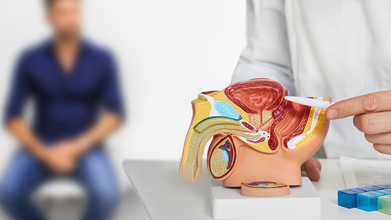- Health Conditions A-Z
- Health & Wellness
- Nutrition
- Fitness
- Health News
- Ayurveda
- Videos
- Medicine A-Z
- Parenting
- Web Stories
Should You Turn Off Your Wifi Router Before Sleep?

Credits: Canva
A wave of social media posts has sparked curiosity around a simple bedtime habit: switching off your Wi-Fi router at night. Some claim it boosts sleep quality, reduces headaches, and even improves mental clarity. But is there any science to back this? Here's what experts say happens when you turn off your Wi-Fi for seven nights in a row.
Does Wi-Fi Radiation Affect Your Body?
Wi-Fi routers emit non-ionising radiation — a low-level form of electromagnetic radiation (EMF) — that is widely considered safe under normal household exposure. Dr Hiran S. Reddy, consultant physician, diabetologist, and critical care specialist at Gleneagles Hospital, Hyderabad, who spoke to Indian Express said that for most people, turning off the router is unlikely to cause any physiological changes.
“WiFi devices emit low-level, non-ionising radiation, which current scientific consensus deems safe at everyday exposure levels,” he explained.
However, Dr Reddy noted that people who report heightened sensitivity to electromagnetic fields — a condition known as electromagnetic hypersensitivity — may experience perceived relief from symptoms like headaches, fatigue, and sleep disturbances. But clinical evidence for this condition remains inconclusive.
Is Sleep Impacted by Wi-Fi Signals?
Dr Sudhir Kumar, consultant neurologist at Apollo Hospitals, Hyderabad, speaking to Indian Express told that most studies on Wi-Fi radiation have been conducted on animals. “There’s no conclusive evidence that Wi-Fi disrupts melatonin production from the pineal gland or interferes with human sleep,” he says.
He explains that Wi-Fi routers typically operate at 2.4 GHz or 5 GHz frequencies, which emit far less energy than a mobile phone held close to the head. At common indoor distances (1–2 metres), the signal strength drops significantly, making it unlikely to influence melatonin or sleep in any measurable way.
The Real Sleep Disruptor: Screen Time
Interestingly, both doctors agree that if anything is affecting sleep, it’s likely the screen time, not the router itself. Blue light emitted from phones, tablets, and laptops interferes with the pineal gland and suppresses melatonin — the hormone that regulates the sleep-wake cycle.
“Disabling Wi-Fi might reduce digital engagement, particularly screen exposure late at night. That can indirectly improve melatonin production and sleep quality,” says Dr Reddy.
Better Sleep Hygiene, Not Less Radiation
While switching off your Wi-Fi router for seven nights won’t likely cause direct changes in your brain or body, it may lead to better bedtime routines. Less internet access could mean fewer late-night scrolls, reduced digital distractions, and an earlier wind-down — all of which support better sleep hygiene.
“Quality sleep enhances everything from mood and cognitive function to immune health,” Dr Reddy noted.
What Does The Study Say?
As per the 2020 study published in the International Journal of Hygiene and Environmental Health, titled: Spending the night next to a router – Results from the first human experimental study investigating the impact of Wi-Fi exposure on sleep, a night of Wi-Fi exposure doesn’t seem to cause sleep problems for healthy young men — but it might make very subtle changes in brain activity that scientists are still trying to understand.
How Was The Study Conducted?
Researchers studied how Wi-Fi exposure might affect sleep. They invited 34 healthy young men (average age around 24) to stay in a sleep lab for five nights. The first night helped them get used to the lab. Then, they had two test nights — each one following a “normal” night to compare results.
During the test nights, some participants were exposed to Wi-Fi signals (at 2.45 GHz, like your home router), while others got fake (sham) signals. The researchers didn’t tell the participants which one they were getting. Sleep was measured in two ways:
Subjective sleep: How well participants felt they slept (through a questionnaire).
Objective sleep: What actually happened in their brains and bodies during sleep (measured using special equipment called polysomnography).
What They Found
The Wi-Fi signals did not cause any major or noticeable effects on:
- How well participants thought they slept
- The general structure and stages of their sleep (called sleep macrostructure)
However, a detailed look at brain activity showed a small change:
There was a slight decrease in brain wave activity in the alpha frequency range (8–11.75 Hz) during deep (non-REM) sleep when Wi-Fi was on. This change is called a reduction in EEG alpha power.
What It Means
Wi-Fi signals didn’t seem to change how people felt they slept or the main parts of their sleep.
There was a small, measurable brain activity change, but it’s unclear if this has any real impact on health or sleep quality.
3 Fertility Truths Every Woman Should Know, According To A Gynecologists

(Credit-Canva)
Infertility impacts millions across the globe, touching both men and women alike. According to the World Health Organization, around 17.5% of the global population, roughly one in six people, experience fertility challenges. This condition can significantly reduce or even prevent natural conception.
Yet, despite its prevalence, infertility remains clouded by myths and misconceptions, many of which unfairly place the blame solely on women. Seeking to debunk these long-held beliefs, Dr. Holly Miller, an American Board-certified obstetrician and gynecologist, took to Instagram to share three important truths every woman should know about fertility.
3 Truths About Fertility Women Should Know
With the help of modern medicine and medical interventions like IVF, fertility treatment can help people boost their chances of reproducing.
Infertility Isn't Just a Woman's Issue
It’s important to understand that infertility affects both partners — it’s not solely a woman’s issue. Blaming only the woman is both unfair and inaccurate. In fact, experts find that the causes of infertility are almost evenly split between men and women.
Roughly one-third of infertility cases are linked to the woman, another third to the man, and the remaining third result from issues affecting both partners — or from causes that doctors are unable to clearly identify.
To identify the cause of infertility, both partners should undergo testing simultaneously. For men, a semen analysis — a quick and straightforward test — is often the easiest and most informative first step.
The "Wait One Year" Rule Changes with Age
Most couples automatically try to conceive for a full 12 months before they think about seeing a fertility doctor. However, the doctor emphasizes that the woman's age is the single most important factor that affects the chances of successful treatment.
If you are under 35 years old: You can safely try for a full 12 months of regular, unprotected sex before seeking a specialist.
If you are 35 or older: You should contact a specialist after only 6 months of trying without success.
If you are 40 or older: You need to see a specialist right away—as quickly as you possibly can.
The doctor explains that after age 35, the woman's egg supply starts to decline more quickly. Time is essential, so couples should strongly ask their doctors for an early referral.
"Unexplained Infertility" Often Means "Undiagnosed Problem"
When a couple is diagnosed with "unexplained infertility," which happens in about 10% to 20% of cases, it means the basic first tests did not find a clear reason. This can be upsetting, but it does not mean you can never have children. In the doctor's experience, the term "unexplained" often means there are hidden problems, such as:
- Small issues with the male partner's sperm that were missed by the basic tests.
- A hidden condition called Endometriosis, which can only be confirmed by a surgical procedure.
- Not having sexual intercourse at the best time or not often enough.
Hyderabad Neurologist Shares Case Of 25-Year-Old Software Engineer Diagnosed With ‘Tennis Elbow’ Caused by Computer Overuse

(Credit-Canva)
In today's corporate world, desk jobs have become the order of the day and so are the health problems associated with them. Endless typing, long hours of sitting, and poor posture are silently taking their toll on young professionals who spend most of their day glued to screens. Many don't realize that their daily work habits could trigger unexpected medical conditions.
Such a growing concern was once highlighted by Hyderabad-based neurologist Dr Sudhir Kumar, who recently shared a case on X. He wrote about one such case of Riya (name changed), a 25-year-old software engineer who developed a sharp, burning pain in her elbow-a pain which began as a minor ache while typing and gradually became so severe that even lifting a teacup felt unbearable.
What was the cause of the sharp elbow pain that Riya experienced?
Riya tried everything she could think of: Rest, pain relief balms, painkillers, even switching hands while using her computer, but the pain refused to fade. When she finally decided to visit the doctor, her symptoms immediately pointed to something unexpected: Tennis elbow. The diagnosis came as a surprise, considering she had never even held a tennis racket. On examination, Dr Sudhir Kumar found the tell-tale signs of the condition, medically known as lateral epicondylitis — tenderness along the outer elbow and pain when she tried to extend her wrist. He explained that the culprit wasn’t a sport, but repetitive strain from long hours at the computer — a problem increasingly common among desk workers.
What is Tennis Elbow?
The Mayo Clinic describes tennis elbow, medically termed lateral epicondylitis, as a painful condition resulting from the overuse of muscles and tendons in the forearm. It develops where these tissues are repeatedly strained by similar wrist and arm movements, leading to tiny tears and inflammation near the elbow.
The name is misleading, and you don't have to be an athlete to get tennis elbow. As a matter of fact, most people who develop it never have used a racket. It's common for the condition to strike people in jobs that require repetitive motions: plumbers, carpenters, painters, butchers, and yes, office workers who spend hours typing or using a mouse.
The pain generally arises on the outside of the elbow, precisely at that bony prominence to which the muscles of the forearm attach. For some, the discomfort may extend into the forearm or even the wrist, making most activities quite arduous.
How Can Tennis Elbow Be Treated?
Once the diagnosis was confirmed, Dr Sudhir Kumar focused on addressing the underlying cause — repetitive stress and poor workstation ergonomics. The holistic treatment for Riya included the following:
- Avoided repetitive activities that triggered her pain.
- Adjusting the computer setup and improving posture.
- Establish a physiotherapy regimen to stretch, strengthen, and gradually build muscle endurance.
- A short course of anti-inflammatory medication
Employing a counterforce brace-a tennis elbow strap-to reduce strain in daily activities. By her six-week follow-up, Riya’s pain had completely resolved. Her grip strength was back, and she could type, lift, and exercise without discomfort. Three months later, she was symptom-free — and far more aware of how small ergonomic changes can make a big difference.
80% Americans Do Not Know THIS Key Fact About Early Prostate Cancer Symptoms

(Credit-Canva)
Prostate cancer is one of the leading causes of cancer deaths, however, a recent survey showed that most people don’t know this vital fact about prostate cancer symptoms.
Prostate cancer is a serious illness in the US, affecting over 300,000 men each year and causing more than 35,000 deaths, according American Cancer Society. This makes it the second-most deadly cancer for men. If doctors detect the disease early, it is treatable. However, patients usually don't notice any signs of the disease in its beginning stages. Due to this lack of symptoms, checking for the disease is extremely important.
A recent survey of 1,004 U.S. adults, commissioned by the Ohio State University Comprehensive Cancer Center, aimed to gauge public knowledge of the disease. The findings highlight a critical need for better education.
What Do Americans Know About Early-Stage Prostate Cancer?
The results showed that most people, 80% of those surveyed, are unaware that early prostate cancer usually has no physical symptoms. One health specialist noted that it's crucial for everyone to understand that this cancer causes no symptoms until it has become advanced. The survey also revealed other gaps in knowledge:
- More than half of the people surveyed (59%) did not know that changes in sexual function could be a sign of prostate cancer.
- The survey noticed some differences across groups. For example, one minority group was better at identifying less common signs like tiredness and weight loss.
- However, that same minority group was less likely than others to correctly identify that the cancer usually has no symptoms in its early stage.
What Is The Best Way To Diagnose Prostate Cancer?
The fact that prostate cancer often begins without symptoms is the main reason doctors worry.
Lack of Symptoms
In its early phase, the cancer is small and contained within the prostate gland. It doesn't push on or block any other body parts, so it doesn't cause pain or discomfort. Because the cancer is deep inside the body, it's hard to tell if someone has it without special tests.
Provider Worry
Because men feel fine, they may wrongly believe they aren't at risk. This feeling of being safe often makes men hesitant to get screened. Since there are no symptoms to look for, screening tests, usually a simple blood test or a physical exam, are the best way to find the cancer early.
What Are Some Signs of Prostate Cancer?
Even though most men with early prostate cancer feel completely normal, there are certain signs that might appear if the disease is more advanced. These symptoms include:
- Having trouble starting to urinate.
- Having a urine flow that is weak or stops and starts.
- Needing to urinate often, especially during the night.
- Difficulty completely emptying the bladder.
- Feeling pain or a burning sensation while urinating.
- Noticing blood in the urine or semen.
- Feeling pain in the back, hips, or pelvis that doesn't go away.
- Experiencing pain during ejaculation.
When Should You Get Screened For Prostate Cancer?
According to American Cancer Society, health organizations advise men to talk with their doctors about getting checked for prostate cancer starting at certain ages, depending on their personal risk.
Average Risk: Age 50
Men who have no special risk factors.
High Risk: Age 45
Men who are African American or who have a father or brother who was diagnosed before age 65.
Highest Risk: Age 40
Men who have more than one close relative (father or brother) diagnosed at an early age. There is no one-size-fits-all advice for screening. Men should always speak to their doctor about their own risk and discuss the pros and cons of testing. Since there are no early warning signs, talking to a doctor about screening is described as "critical" and a simple process that could potentially save a man's life.
© 2024 Bennett, Coleman & Company Limited

